![]()
![]()
![]()
Use LEFT and RIGHT arrow keys to navigate between flashcards;
Use UP and DOWN arrow keys to flip the card;
H to show hint;
A reads text to speech;
36 Cards in this Set
- Front
- Back
- 3rd side (hint)
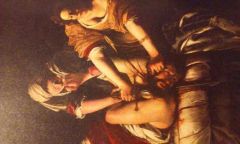
|
N: Judith slaying Holofernes D: 1614 - 1620 CE (17c) P: Baroque A: Artemisia Gentileschi OL: Italy (Florence?) P: unknown (Medici?) M/T: oil on canvas F: Possible religious propaganda in favor of Catholicism. Also artist's own personal incorporation. DT: Tenebrisim C: The Judith story had become popular during the Renaissance. Judith was a powerful female figure. |
¯\_(ツ)_/¯ |
|
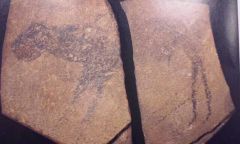
|
N: Apollo 11 (Animal facing left.) D: 23,000 BCE P/S: global prehistory A: unknown OL: Apollo 11 cave, Namibia P: none M/T: charcoal on stone F: narrative DT: silhouette C: what was seen |
¯\_(ツ)_/¯ |
|
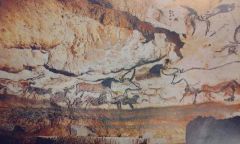
|
N: Hall of the Bulls D: 15,000 BCE P/S: global prehistory A: unknown OL: France P: none M/T: Charcoal/rock on stone F: narrative DT: silhouette C: social; showing what was seen |
¯\_(ツ)_/¯ |
|
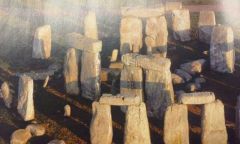
|
N: Stonehenge D: 2,550 - 1,600 BCE P/S: neolithic A: unknown OL: Wiltshire, England P: none M/T: stones F: pegan worship DT: circle; trilithons C: religious; worshipping; |
¯\_(ツ)_/¯ |
|
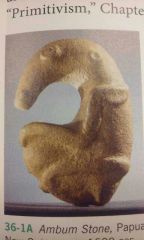
|
N: Ambum Stone D: 1500 BCE P/S: Neolithic A: unknown OL: Papua, New Guinea P: n/a M/T: stone F: DT: subtractive method C:
|
|
|
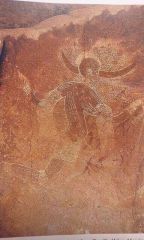
|
N: Running woman rock painting D: 6000 - 4000 BCE P/S: G A: unknown OL: Tassili n'Ajjer, Algeria P: unknown M/T: rock painrubfw F: possible ritual use DT: C: |
¯\_(ツ)_/¯ |
|
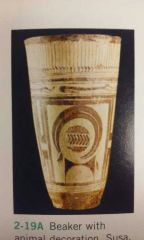
|
N: Beaker with Ibex motifs D: 4000 BCE P/S: global prehistory A: unknown OL: Sousa, Iran P: none M/T: clay pot shaped by subtraction method F: honoring dead? DT: geometric shapes on breaker C: very decortive |
¯\_(ツ)_/¯ |
|
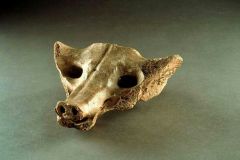
|
N: Camelid Sancrum D: 14000_7000 bce P/S: global prehistory A: unknown OL: Mexico P: none M/T: sacrum of a camelid F: fertility? DT: camelid sacrum in the shape of a canine C: |
|
|

|
N: anthromorphic steleD: fourth milenium bceP/S: global prehistoryA: unknownOL: arabian peninsula P: noneM/T: charcoal on stoneF: DT: horse like figure C: shows that they donesticated horses long before |
|
|
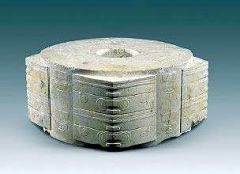
|
N: Jade Cong D: 3300-2200 BCE P/S: global prehistoric A: unknown OL: Liangzhu, China P: none M/T: jade/nephrite carved with sandy like material F: unknown DT: square and hollow tubes decorated with highly detailed shapes. C: |
|
|
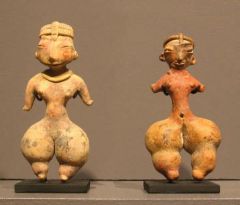
|
N: Tlatilco Female Figurine D: 1200-900 bce P/S: global prehistory A: unknown OL: Central Mexico (Tlatilco near water) P: n/a M/T: ceramic clay F: buried near timbs with the dead DT: various figurines C: found |
|
|
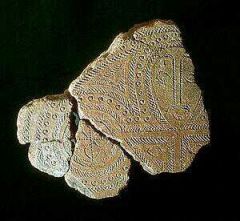
|
N: Terra cotta fragment Lapita D: 100 bce P/S: global prehistory A: unknown OL: solomon islands, reef island P: none M/T: ceramic F: pottery DT: piece of pottery C: usef for cooking? storage? |
|
|
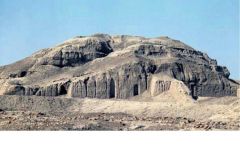
|
N: White Temple and its ziggurat D: 3500-3000 BCE P/S: Ancient Mediterranean A: unknown OL: Uruk (Warka, Iraq) P: unknown M/T: brick F: served as a temple; where gods and humans meet DT: brick temple; steps and platform C: had statutes placed in temple; offering |
|
|
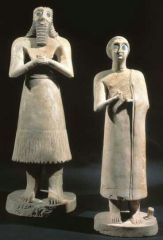
|
N: Statutes of Votive figures from square temple at Eshnnunna D: 2900-2350 BCE P/S: Ancient Mediterranean; Sumerian A: unknown OL: Eshnunna (Tell Asmar, Iraq) P: uunknown; there was M/T: sculpted gypsum inlaid with; shell; black limestone F: placef in temples to hold their place in the after life DT: statutes; human figures; enlarged eyes; hands in a gesture of prayer C: found buried beneath the floor of a temple in Eshnunna |
|
|

|
N: Standard of Ur D: 2600-2400 bce P/S: Ancient Mediterranean A: unknown OL: Ur (Southern Iraq) P: none M/T: wood inlaid with; shells; lapiz lazuli; red limestone F: soundbox for musical instrument; or carried on a pole DT: a blue and red hollow box with rregistrars; depictions of war and peace C: found in one if the largest tombs |
|
|
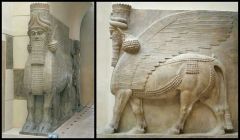
|
N: Lamassu from the citaldel of Sargon II D: 720-705 bce P/S: Ancient Mediterranean; Assyrian A: unknown OL: Dur Sharrukin (Khorsabad, Iraq) P: none M/T: limestone F: the protection snd support of assyrian door ways DT: a carved limestone rock; in the shape of a creature with human face and an animalistic body C: intimidation |
|
|
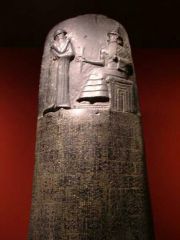
|
N: The code of Himmurabi D: 1750 bce P/S: Ancient Mediterranean A: unknown OL: Basalt P: none M/T: stele; black 8ft stone carved with laws in cuneiform stele; black 8ft stone carved with laws in cuneiform F: asyrian law code DT: carved stone C: about 300 laws; first set of enforced written law code |
|
|
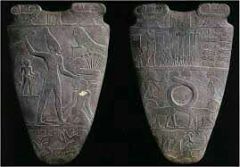
|
N: Palette of King Narmer D: 3000-2920 BCE P/S: Predynastic Egypt; Ancient Mediterranean A: unknown OL: Egypt P: none M/T: greywacke F: used to ground up make DT: tears; gray; a giant narmor; intwined lion heads C: sybolizes unification of egypt |
|
|

|
N: Pyramids of Gizeh¿ D: 2500-2300 BCE P/S: Predynastic Egypt; Ancient Mediterranean A: unknown; slaves OL: Egypt P: none M/T: limestone F: a tomb for pharaohs DT: three different sized pyramids; once white with limestone C: pyramid shape usef to help pharaohs acwnt yo the afterlife safely |
|
|
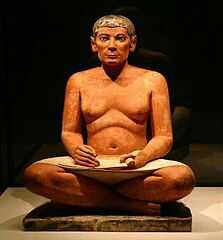
|
N: Seated Scribe D: 2620-2500 BCE P/S: Predynastic Egypt; Ancient Mediterranean A: unknown OL: Saqqara, Egypt P: unknown; pharaoh ? M/T: painted limestone F: possible honoring for a scribe whom was favoref by the pharaoh DT: a scribe seated and writting doen what is occurring C: |
|
|
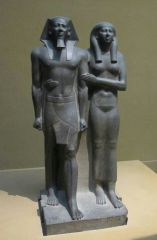
|
N: King Menkaura and queen D: 2490-2472 BCE P/S: Predynastic Egypt; Old Kingdom fourth dynasty A: unknown OL: Egypt P: unknown; pharaoh? M/T: greywacke F: show the status of the pharaoh DT: the pharaoh and his queen holding onto his arm; one foot forward C: high status of the pharaohs |
|
|
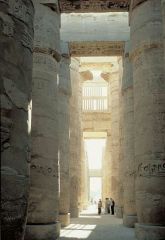
|
N: Temple of Amun-Re and Hypostyle Hall D: 1500 (Temple); 1250 (hall) BCE P/S: Predynastic Egypt; Ancient Mediterranean A: unknown; slaves? OL: Karnak, Egypt P: unknown M/T: cut sand stone and mudd brick F: used to ground up make DT: giant columns all around tje building C: having various columns around the inside of the temple helped support the heavy weight of the materials used |
|
|
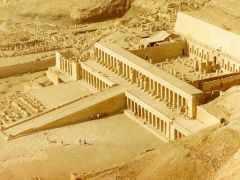
|
N: Mortuary Temple. of Hatshepsut D: 1353-1335 BCE P/S: Predynastic Egypt; Ancient Mediterranean A: unknown; slaves OL: near Luxor, Egypt P: pharaoh? M/T: ssandstone; partially carved into rock cliff; red granite F: used to ground up make DT: cliff carving C: built for the queen as her sanctuary |
|
|
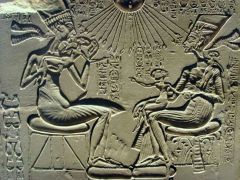
|
N: Akhenaten, Nefertitie and three daughters D: 1352-1335 BCE P/S: Predynastic Egypt; New Kingdom A: unknown; slaves OL: Egypt P: none M/T: limestone F: Depict Skhennaten and his family DT: religious sculpture honoring the new god Aten C: a |
|
|
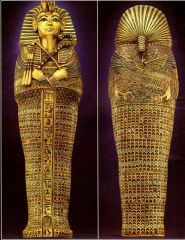
|
N: Tutankhamuns tomb D: 1323 BCE P/S: Predynastic Egypt; Ancient Mediterranean A: unknown; slaves OL: Egypt P: none M/T: gold iinlay of enamel F: to burry the pharaoh DT: a three part ssarcophagus; C: used to burry the pharaoh king tut |
|
|

|
N: last judgment of hu nefer¿ D: 720-705 BCE P/S: Predynastic Egypt; Ancient Mediterranean A: unknown; slaves OL: Egypt P: none M/T: painted papyrus scroll F: to show the honoribg of gu nefer a scribe DT: the gods determine whether he get to the afterlife or not C: a well respected scr be |
|
|
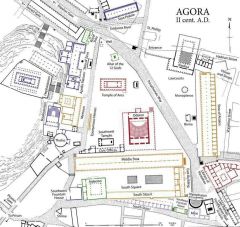
|
N: Athenian Agora D: 600 BCE -150 CE P/S: Archaic - Hellenistic ; Ancient Mediterranean A: unknown; OL: Athens P: none M/T: Plan F: was a place of market; business; center of politics DT: various buildings and plans consisted of it C: Athenins would use it as their central place; the birthplace of democracy |
|
|
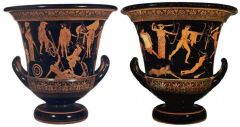
|
N: Nubides Krater D: 460-450 BCE P/S: Classical Greece ; Ancient Mediterranean A: anonymous; Niobid Painter OL: Egypt P: unknown M/T: clay; red-figure technique (white highlights) F: krater vase to hold things DT: C: a well respected scr be |
|
|

|
N: Peplos Kore D: 530 BCE P/S: Archaic Greece ; Ancient Mediterranean A: anonymous; OL: the Acropolis P: unknown M/T: Marbel; Painted details Marbel; Painted details F: votive figures for a goddess DT: a woman in a traditional dress; originally bright on color; now white and faded C: a well respected scr be |
|
|

|
N: Doryphoros (spear barer) D: 450-440 BCE P/S: Classical Greece ; Ancient Mediterranean A: Polykleitus; OL: Herculaneum P: unknown M/T: Marbel; F: depiction of the ideal human body DT: realism, iconicC: believed to be her |
|
|
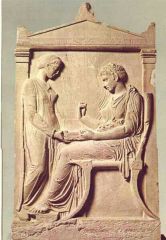
|
N: Grave Stele of Hegeso D: 410 BCE P/S: Archaic Greece ; Ancient Mediterranean A: kallimachos; OL: Kerameikas, Athens Greece P: unknown M/T: Marbel; Pentelic; Painted details F: grave stone to honor the dead DT: life like (izh) C: for a deceased daighter of Proxemos |
|
|
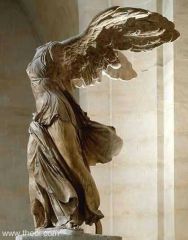
|
N: Nike of Samothrace D: 200-190 BCE P/S: Hellenistic Greece ; Ancient Mediterranean A: unknown; OL: Samothrace, Greece P: unknown M/T: Marbel; F: naval victoryDT: realistic; polytheisticC: made to honor greek goddess Nike; as well as sea battle |
|
|

|
N: Seated Boxer D: 100 BCE P/S: Hellenistic Greece ; Ancient Mediterranean A: anonymous; OL: Quivinial Seven Hills of Rome P: unknown M/T: Bronze; lost wax castingF: decorative athleteDT: ugly and defeated athleteC: possible religious connection/human like |
|
|
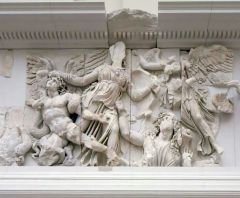
|
N: Great Altar of Zeus and Athena D: 175 BCE P/S: Hellenistic Greece ; Ancient Mediterranean A: anonymous; OL: asia minor P: unknown M/T: Marbel; F: worshipDT: large and deepC:battle between the olympians |
|
|
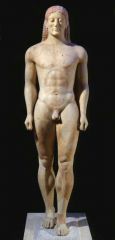
|
N: Anavysos Kouros D: 530 BCE P/S: Archaic Greece ; Ancient Mediterranean A: anonymous; OL: greece P: unknown M/T: Marbel; Painted details Marbel; Painted details F: votive figures for a goddessDT: grave mmarket; offering to gods C: for dead battle fighting youth |
|
|
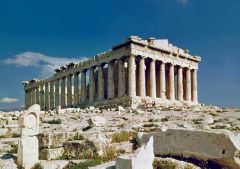
|
N: Parthenon D: 447-424 BCE P/S: Archaic Greece ; Ancient Mediterranean A: anonymous; OL: Athens, Greece P: unknown M/T: Marbel; stone; used mathematicsF: AArchitecture; to house the gods DT: religiousC: symbol of athenian democracy |
|

